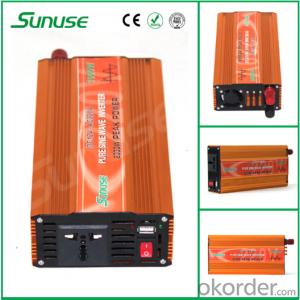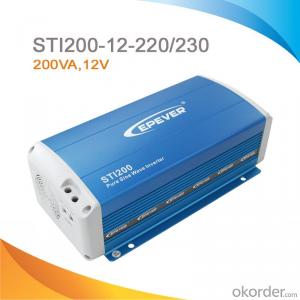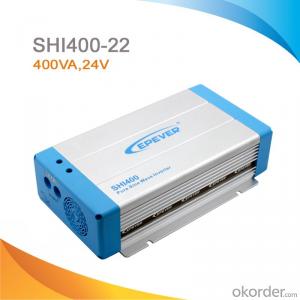Solar Inverter Box:Off Grid 1000W DC 12/24V to AC 110/220V Pure Sine Wave Inverter
- Loading Port:
- Qingdao
- Payment Terms:
- TT OR LC
- Min Order Qty:
- 50000 watt
- Supply Capability:
- 3000000 watt/month
OKorder Service Pledge
OKorder Financial Service
You Might Also Like
1. Structure of Off Grid 1000W DC 12/24V to AC 110/220V Pure Sine Wave Inverter Description
A solar inverter, or PV inverter, or Solar converter, converts the variable direct current (DC) output of a photovoltaic (PV) solar panel into a utility frequency alternating current (AC) that can be fed into a commercial electrical grid or used by a local, off-grid electrical network. It is a critical BOS–component in a photovoltaic system, allowing the use of ordinary AC-powered equipment. Solar inverters have special functions adapted for use with photovoltaic arrays, including maximum power point tracking and anti-islanding protection.
2. Main Features of the Off Grid 1000W DC 12/24V to AC 110/220V Pure Sine Wave Inverter
﹒convert 12V/24V DC to 220V/110V AC to supply for the electronic products such as player MP3, player MP4
﹒DC 12/24V to AC 110/220V
3. Off Grid 1000W DC 12/24V to AC 110/220V Pure Sine Wave Inverter Images

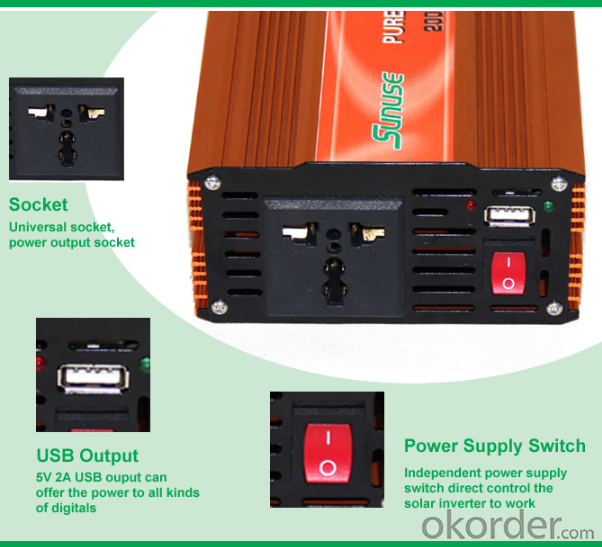
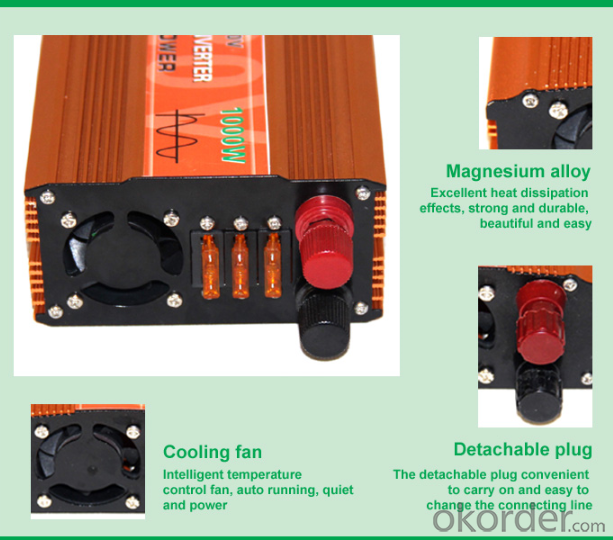

4. Off Grid 1000W DC 12/24V to AC 110/220V Pure Sine Wave Inverter Specification
Specifications: | |||
Type: | 1000W 12V | 1000W 24V | 1000W 48V |
Input DC Voltage Range: | 11-15V DC/22-31V DC/44-62V DC | 11-15V DC/22-31V DC/44-62V DC | 11-15V DC/22-31V DC/44-62V DC |
Under-voltage Protective: | 10.0±0.3V DC/20.0±0.8V DC | 10.0±0.3V DC/20.0±0.8V DC | 10.0±0.3V DC/20.0±0.8V DC |
Under-voltage Alarm: | 10.5±0.3V DC/21.0±0.8V DC | 10.5±0.3V DC/21.0±0.8V DC | 10.5±0.3V DC/21.0±0.8V DC |
Over Voltage Protective: | 16.0±0.3V DC/31.0±0.8V DC | 16.0±0.3V DC/31.0±0.8V DC | 16.0±0.3V DC/31.0±0.8V DC |
Over Voltage Recovery: | 15.0±0.3V DC/29.0±0.8V DC | 15.0±0.3V DC/29.0±0.8V DC | 15.0±0.3V DC/29.0±0.8V DC |
Max Power: | 1000W | ||
Peak Power: | 2000W | ||
USB: | 2000mA | ||
Reverse Protecion: | Blown fuses | ||
Over Load Protection Power: | 110%-120% | ||
Quiescent Current: | ≤0.4A | ||
Max. Efficiency: | ≥92% | ||
Total Harmonic Distortion: | ≤3% Linear load(pure sine wave) | ||
Status Indicator Lamp: | Work: Green LED Failure: Red LED and alarm LED Display: Voltage, Current, Power(optional) | ||
Usage: | for a car, truck, boat, home or standard battery; or solar system, etc. | ||
Work condition: | Operating Temperature: -10~40°C Opetating Humidity: 10--90%(non-condensate) | ||
5. FAQ of Off Grid 1000W DC 12/24V to AC 110/220V Pure Sine Wave Inverter
Q1. What is the difference between inverter and solar inverter?
A1. Inverter only has AC inpput, but solar inverter both connect to AC input and solar panel, it saves more power.
Q2. What is the difference between MPPT&PWM?
A2. MPPT has higher efficiency, it can track the max power point and won't waste energy.
Q3. What is the waranty of product?
A3. 12 months.
- Q: What are the common maintenance requirements for a solar inverter?
- The common maintenance requirements for a solar inverter include regular inspections to ensure proper functioning, cleaning of the unit and its components to remove dust and debris, checking and tightening of electrical connections, monitoring for any signs of damage or wear, and updating firmware or software as needed. Additionally, keeping the inverter's surrounding area clean and free from obstructions is also important for optimal performance.
- Q: Is the grid side of the grid and the inverter?
- The grid load side of the grid is the grid. The inverter is an important part of the PV grid-connected system and can not be regarded as an external load. Photovoltaic power generation system is included in both grid and off-grid.
- Q: How does the weight of a solar inverter affect its installation process?
- The weight of a solar inverter can significantly impact its installation process. Heavier inverters may require additional support structures or mounting equipment to ensure proper installation and stability. They may also require more manpower and specialized equipment during the installation process. Conversely, lighter inverters may be easier to handle and install, potentially reducing installation time and effort. Therefore, the weight of a solar inverter is an important consideration that can influence the overall installation process.
- Q: How does a solar inverter handle variations in solar irradiation?
- A solar inverter handles variations in solar irradiation by continuously monitoring the amount of sunlight received and adjusting the conversion of direct current (DC) power generated by the solar panels into alternating current (AC) power accordingly. It does this by employing maximum power point tracking (MPPT) algorithms that optimize the power output from the panels, ensuring maximum efficiency regardless of the fluctuations in solar irradiation.
- Q: What is the role of voltage support in a solar inverter?
- The role of voltage support in a solar inverter is to ensure that the output voltage from the inverter remains stable and within acceptable limits. It helps regulate the voltage to match the requirements of the connected load, preventing any voltage fluctuations or overvoltage conditions that could potentially damage the equipment or disrupt the operation of the solar power system.
- Q: Can a solar inverter be used with a solar-powered telecommunications system?
- Yes, a solar inverter can be used with a solar-powered telecommunications system. A solar inverter is responsible for converting the direct current (DC) generated by solar panels into alternating current (AC) that can be used to power electrical devices. In the case of a solar-powered telecommunications system, the solar inverter would convert the DC power generated by the solar panels into AC power to effectively operate the telecommunication equipment.
- Q: What is the role of a solar inverter in a battery storage system?
- The role of a solar inverter in a battery storage system is to convert the direct current (DC) electricity produced by the solar panels into alternating current (AC) electricity, which is compatible with the electrical grid and can be used to power household appliances or feed back into the grid. Additionally, the solar inverter manages the charging and discharging of the batteries, ensuring efficient energy storage and usage.
- Q: How does a solar inverter handle voltage and frequency regulation?
- A solar inverter handles voltage and frequency regulation by converting the direct current (DC) generated by solar panels into alternating current (AC) that matches the voltage and frequency of the electrical grid. It does this by using advanced power electronics and control systems to monitor and adjust the output voltage and frequency to meet the required standards. This ensures that the electricity generated by the solar panels is compatible with the grid and can be seamlessly integrated into the existing power supply.
- Q: Can a solar inverter be used in a commercial or industrial setting?
- Yes, a solar inverter can be used in a commercial or industrial setting. In fact, they are commonly used in these settings to convert the direct current (DC) electricity generated by solar panels into alternating current (AC) electricity that can be used to power various commercial and industrial equipment. Solar inverters are essential components of solar power systems in such settings and play a crucial role in maximizing energy efficiency and reducing reliance on conventional power sources.
- Q: What is the role of a solar inverter in fault ride-through capability?
- The role of a solar inverter in fault ride-through capability is to ensure that the solar power system remains operational and stable during grid faults or disturbances. The inverter is responsible for detecting fault conditions and adjusting its output to mitigate the impact of the fault on the system. By providing fault ride-through capability, the solar inverter helps maintain grid stability and ensures continuous power supply from the solar panels even in the presence of faults.
Send your message to us
Solar Inverter Box:Off Grid 1000W DC 12/24V to AC 110/220V Pure Sine Wave Inverter
- Loading Port:
- Qingdao
- Payment Terms:
- TT OR LC
- Min Order Qty:
- 50000 watt
- Supply Capability:
- 3000000 watt/month
OKorder Service Pledge
OKorder Financial Service
Similar products
Hot products
Hot Searches
Related keywords
